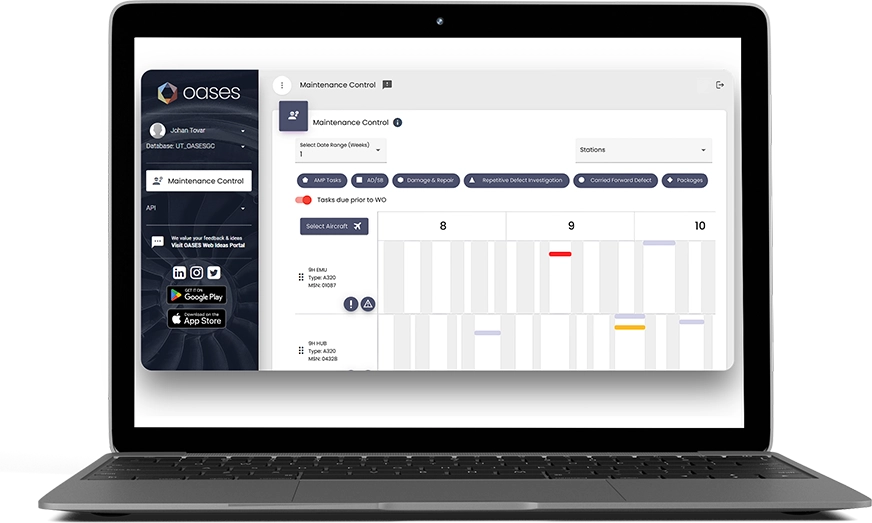From Runway to Boardroom: Leveraging Airline MRO Software for Competitive Advantage and Business Growth
In the competitive aviation industry, success hinges on staying ahead through innovative strategies and technological advancements. At the forefront of this race is the implementation of Maintenance, Repair, and Operations (MRO) software, a tool that is proving to be a game-changer from the runway to the boardroom. This article reviews how it transforms aviation maintenance management in both contexts.
The Evolving Landscape of the Aviation Industry
The aviation industry has evolved dramatically since the days when the early pioneers made the first flights across the Atlantic. Consider Ryanair, for example; in 2002, the airline carried 11.1 million passengers – fast-forward to 2022/2023 and the total passenger count was 169 million.
From the infrequent air travel of the 20th century to today’s highly efficient, customer-centric operations, the sector has seen a complete transformation – and these changes have been driven by advancements in technology and a growing emphasis on safety and customer satisfaction.
Globalisation has been another driver, greatly increasing demand for both passenger airlines and freight carriers. Commercial air travel has almost reached pre-pandemic levels and by 2024, the freight forwarding market is forecast to reach a value of USD 178 billion, a 23% increase from 2018 levels.
Modern airlines face a barrage of challenges – not only in terms of keeping up with the demand while providing consistent service – but also the volatility of fuel prices, increasing environmental concerns, and the ever-growing demands of passengers for efficiency and punctuality. These hurdles necessitate a strategic approach, where precision, agility, and foresight play pivotal roles.
The key to unlocking precision, agility and foresight is to have efficient systems and processes in place – and that’s the beauty of MRO software.
The Power of Airline MRO Software
MRO software is the key to ensuring that aircraft are ready for flight at the right time and in accordance with continuing airworthiness regulations. It makes use of staggering volumes of data that can improve efficiency – not only in the hangar, but in the boardroom as well.
MRO software provides agility by giving operators comprehensive oversight and full control over planning, scheduling, budgeting, inventory management, and a range of other processes. This control allows airlines to quickly adapt to challenges, whether that’s air traffic control issues, climate change, or supply chain shortages. Let’s look at some of the key features that make this possible.
From Runway…
On the operational front, MRO software is revolutionising how airlines manage their fleet maintenance. It drastically improves turnaround times for aircraft, reducing unplanned downtime and thereby enhancing overall aircraft utilisation. This operational efficiency is not just about speed but also about the precision and quality of maintenance works.
Safety and compliance are other critical areas where MRO software makes a significant impact. It helps ensure that all maintenance activities strictly adhere to aviation standards, mitigating risks of penalties and, more importantly, ensuring the safety of passengers and crew.
Some of the features of OASES that make all the above possible include:
- Maintenance planning and maintenance control: These two modules streamline and automate many planning tasks. For example, maintenance forecasting and defect limitation tasks are integrated into work orders, with documentation automatically generated.
- Line maintenance: Here, you can integrate data feeds from EFB, ETL, e-enabled aircraft and other electronic operations systems, for more efficient control over short term maintenance planning.
- Production: Here, you have everything required for managing resources from the hangar level down to individual tasks.
- Continuing airworthiness: This functionality ensures that aircraft are maintained in accordance with regulatory standards, tracking and documenting all maintenance activities to keep aircraft operationally safe and compliant. Teams can manage all issues regarding reliability, repetitive defects, trends, and remedies, for a compliant maintenance programme.
- Materials management: This feature manages spare parts and other stock, ensuring optimum stock levels, and handling re-ordering when necessary. In essence, it ensures that the right parts are available in the right place when needed, streamlining much of the admin involved.
- Warranty management: This module tracks warranty information for aircraft parts and components, helping airlines to manage claims automatically and win more claims.
- Commercial management: This function provides coordination for all commercial aspects of the business, and a unified platform for handling financial analysis and admin processes relating to invoicing, cross-charging, forecasting, and reporting.
- Customs tracking: Easily view the progress of inbound and outbound shipments while capturing all data required for compliance purposes.
As well as the specific functionality of MRO software, cloud based software such as OASES can integrate with other systems, providing a streamlined ecosystem on the whole. Click here for more information about the above modules.
Cost Savings
MRO software reduces costs in many ways. Here are just a few examples:
- Predictive maintenance: This allow airlines to pre-emptively address potential issues, thus avoiding major repairs.
- Optimised inventory: Through the analysis of usage patterns, MRO software helps airlines maintain an optimal level of inventory, reducing the need to hold excessive, expensive parts, thus cutting holding costs.
- Minimised ground time: MRO software streamlines maintenance scheduling to ensure aircraft spend more time in the air and less on the ground. For example, it can coordinate maintenance tasks during less busy flight periods, decreasing revenue loss from idle aircraft. The option to pre-schedule engineers based on in-flight data is another example of how it contributes.
- Reduced admin costs: Keeping digital records and automating reports reduces administrative overhead. Having more efficient processes also cuts the admin costs. The same goes for compliance; the software reduces the time and resources spent on compliance activities. For instance, the automated tracking of maintenance actions ensures easy compliance verification, saving time and reducing the need for extensive manual audits.
- More approved warranty claims: As mentioned, the warranty management functionality increases the chances of succeeding with claims.
To Boardroom
For strategic planning, MRO software is indispensable. It aids in long-term fleet management, efficient route planning, and crafting expansion strategies that align operational capabilities with broader business goals.
MRO Analytics
Analytics helps decision makers to gain valuable insights; and this data-driven approach is crucial in an industry where margins are tight and every decision has significant financial implications. Having real-time data is also key – as helpful as reporting is, keeping tabs on what the data reveals on a moment to moment basis is vital for responding in a timely manner.
For that reason, we introduced our Business Intelligence tool, OASES Insights. Insights arms airlines with adaptability and the means to forecast costs early so that action can be taken to reduce them ahead of time. Having a robust, comprehensive analytics tool also makes it easier to keep tabs on longer-term trends, leading to long-term cost savings.
Improved Customer Experience
The streamlined operations provided by MRO software reduces delays and enhances safety, which directly translates into an improved customer experience. This improvement is vital for achieving customer satisfaction and building loyalty – both key drivers in an industry heavily reliant on repeat business.
MRO of the Future
Looking ahead, the integration of MRO software with emerging technologies such as the IoT, augmented reality, drones and AI holds immense potential.
Drones can be used to make inspection more efficient, reaching heights that are difficult and dangerous for technicians to access, while computer vision will make the detection of some types of defects more accurate.
The IoT has many applications, whether that’s using RFID tags to track assets or digital twin technology that enables the real-time monitoring and simulation of engine conditions.
As for augmented reality, overlaying digital information (such as instructions and schemas) on aircraft components will help engineers perform more complex tasks with greater accuracy efficiency (and it will also improve engineer training).
AI has numerous applications, including improving the predictive capabilities of analytics software.
Finally, sustainability and green aviation represent another frontier where MRO software and other emerging technologies will play a crucial role. This may include the use of AI and machine learning to uncover fuel usage patterns in order to optimise them.
Conclusion
MRO is the cornerstone of efficient MRO operations, reducing maintenance costs, and empowering data-driven strategic planning. Foresight and adaptability have demonstrated to be the key in overcoming some of the recent challenges the industry has been facing, and MRO software lays the foundation for that.
OASES helps airlines, MROs and CAMOs across the globe to get more value from their data so they can achieve all of the above.
To learn more or book an OASES demo, contact us today
For organisations looking to ascend to new heights of operational excellence, contact us today to book a demo.



